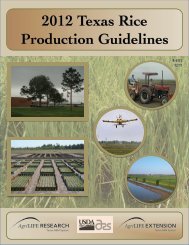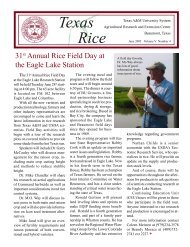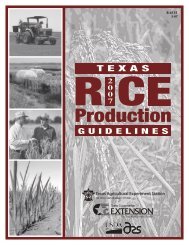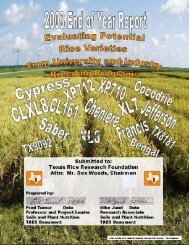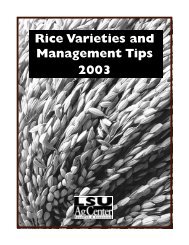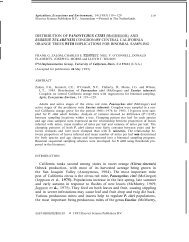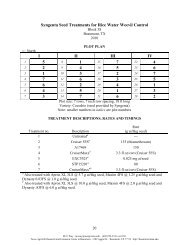Texas Rice - Texas A&M AgriLIFE Research Center at Beaumont ...
Texas Rice - Texas A&M AgriLIFE Research Center at Beaumont ...
Texas Rice - Texas A&M AgriLIFE Research Center at Beaumont ...
You also want an ePaper? Increase the reach of your titles
YUMPU automatically turns print PDFs into web optimized ePapers that Google loves.
Red <strong>Rice</strong> continued...<br />
tion. <strong>Research</strong> by Noldin, Chandler and<br />
McCauley has shown th<strong>at</strong> leaving<br />
stubble and grain to overwinter on the<br />
soil surface will break dormancy and the<br />
seed will germin<strong>at</strong>e (Noldin et al. 1995).<br />
And of course, producers are encouraged<br />
to buy certified or registered rice seed to<br />
reduce the chances of bringing in red rice<br />
by way of seed stock.<br />
Scientists have been working to provide<br />
producers with additional forms of<br />
control. A study conducted by Dr. Richard<br />
Dunand <strong>at</strong> the Louisiana St<strong>at</strong>e University<br />
(LSU) <strong>Rice</strong> <strong>Research</strong> St<strong>at</strong>ion in<br />
Crowley showed th<strong>at</strong> using the plant<br />
growth regul<strong>at</strong>or maleic hydrazide in<br />
combin<strong>at</strong>ion with early m<strong>at</strong>uring conventional<br />
rice varieties had the potential<br />
to provide good control of red rice. In<br />
the experiments, early m<strong>at</strong>uring rice varieties<br />
were allowed to reach the milk<br />
stage of development before the applic<strong>at</strong>ion<br />
of maleic hydrazide. At this stage,<br />
most red rice was just beginning to<br />
flower. Th<strong>at</strong> made it susceptible to the<br />
action of the plant growth regul<strong>at</strong>or,<br />
which inhibits cell division, thereby arresting<br />
seed development. The drawback<br />
to this type of control is twofold. First,<br />
timing the applic<strong>at</strong>ion is critical. If applied<br />
too early, the rice crop will be injured.<br />
If applied too l<strong>at</strong>e, the red rice will<br />
not be effectively controlled. An additional<br />
drawback is th<strong>at</strong> relying on this<br />
form of control assumes there are no<br />
early m<strong>at</strong>uring red rice biotypes in the<br />
area, which we now know may not necessarily<br />
be true.<br />
In 1993, an important discovery was<br />
made by Dr. Tim Croughan of the LSU<br />
<strong>Rice</strong> St<strong>at</strong>ion, which may prove to be the<br />
best hope yet for controlling red rice.<br />
After 12 years of research and thousands<br />
of dead ends, Dr. Croughan produced a<br />
mutant strain derived from an old variety<br />
called AS3510 th<strong>at</strong> was tolerant to<br />
continued on next page<br />
When Tim Croughan started his work in 1981, he had no idea<br />
the winding road th<strong>at</strong> would lead to his discovery of an ‘imi’<br />
tolerant rice. And actually, he started out screening with other<br />
contact herbicides, as the imi chemistry had not yet been developed.<br />
At first Croughan tried cellular level selection in petri dishes,<br />
whereby meristem cells were collected from rice plants, placed<br />
in a growing medium where they began to divide, then exposed<br />
to a contact herbicide. This was a practiced technique, and had<br />
already led to the development of many cultivars. In this case,<br />
though, no resistance was found. Then he tried mut<strong>at</strong>ing rice seeds,<br />
using radi<strong>at</strong>ion and chemicals. The seeds were germin<strong>at</strong>ed and<br />
grown to m<strong>at</strong>urity, and then screened for resistance using the contact<br />
herbicides. After thousands of <strong>at</strong>tempts, nothing was found.<br />
It was around this time th<strong>at</strong> a new family of chemical herbicides<br />
came to the market, the imidazolinones, which are ‘single<br />
site of action’ herbicides. Croughan decided to use the imi herbicides<br />
for his screening process, as it increased the likelihood of<br />
finding a plant with a small genetic change th<strong>at</strong> would still confer<br />
herbicide resistance. Croughan went back to the lab and began<br />
growing tissue cultures, both somaculture (using meristem tissue)<br />
and antherculture. From this tissue, callus cultures were produced<br />
and yielded over 25,000 plants per year. These were grown<br />
out in the greenhouse, and the progeny seed was planted in the<br />
field before the imi herbicide was applied. No resistance was<br />
found.<br />
Nearly 10 years had passed since Croughan began looking<br />
for an herbicide tolerant rice, and it was beginning to look like<br />
the project would not succeed. Going back to a methodology he<br />
had tried early on, Croughan began soaking seeds in a chemical<br />
called ethyl-methane sulfon<strong>at</strong>e (EMS) to induce the mut<strong>at</strong>ions.<br />
EMS has been used for decades by plant breeders to cause point<br />
mut<strong>at</strong>ions, also known as base-pair mut<strong>at</strong>ions, in an effort to develop<br />
improved varieties. In fact, over 1000 varieties of grain<br />
and vegetable crops are available today as a direct result of this<br />
methodology.<br />
Croughan began with 10 varieties of rice, including the old<br />
release Alexandria Seed 3510 (known as AS3510). This line was<br />
included because it was a very early m<strong>at</strong>uring variety, and if the<br />
mut<strong>at</strong>ion was successful, had the potential to produce a variety<br />
resistant to the imi herbicide and flower well ahead of any red<br />
rice th<strong>at</strong> may be present in the field. In 1993, Croughan found a<br />
single plant from the mut<strong>at</strong>ed AS3510 seed th<strong>at</strong> could survive<br />
elev<strong>at</strong>ed levels of the imi herbicide Newp<strong>at</strong>h. The plant was grown<br />
out, its progeny planted in the field and then sprayed with<br />
Newp<strong>at</strong>h. All the plants survived. Dr. Croughan had finally succeeded<br />
and the rest, as they say, is history.<br />
10<br />
A Historical Perspective<br />
*



